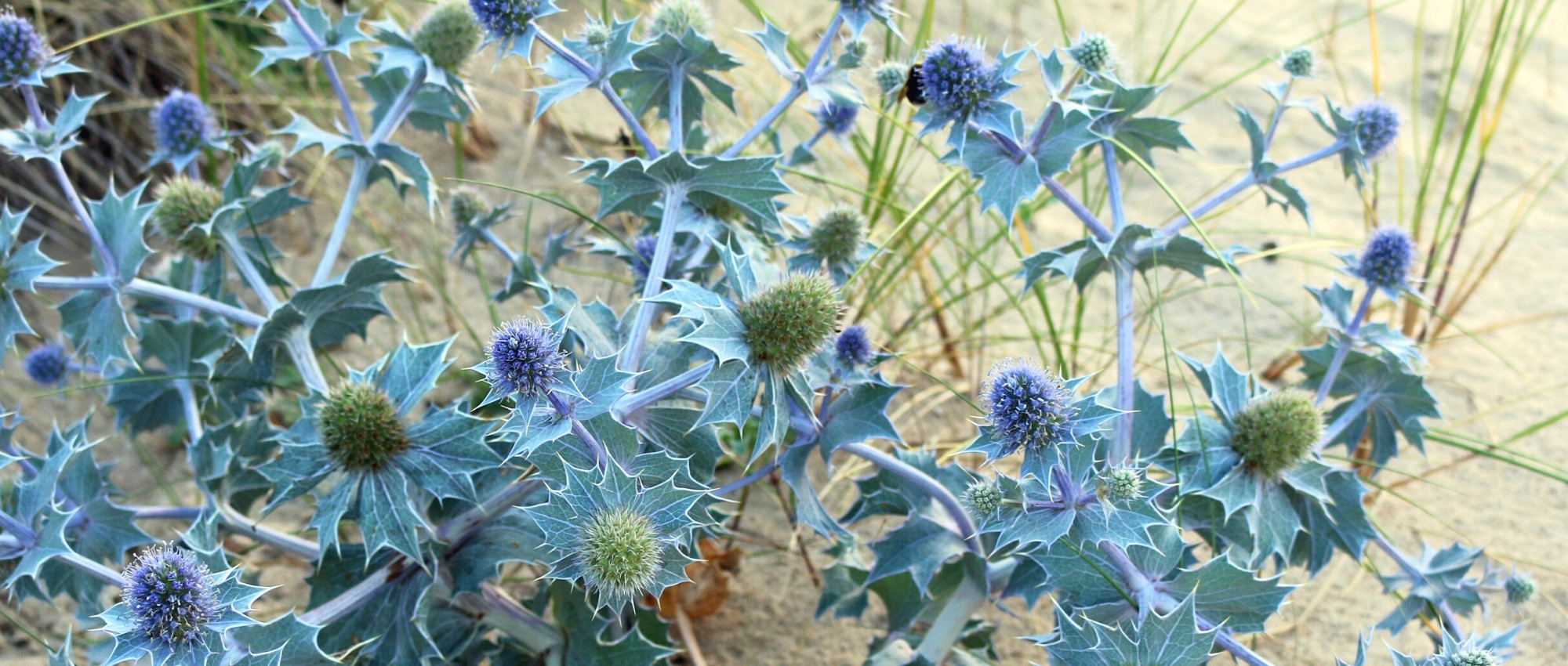
Eryngium: 6 successful pairing ideas
To create stunning borders!
Contents
Eryngiums, or sea hollies, are stunning ornamental thistles that offer a graphic flowering, often in metallic blue or silver hues. They form rounded inflorescences in summer, often adorned with large, highly decorative bracts that are spiny or finely cut. Their flowers are borne on ramified and rigid stems, giving them a lovely, structured silhouette. Easy to grow, Eryngiums are low-maintenance perennials that thrive in dry, stony, well-drained soil. There are many varieties that will fit into different garden styles: seaside gardens, alpine rockeries, graphic gardens, naturalistic, exotic, and more. Discover which plants to pair them with in the garden to create stunning flowerbeds!
In a dry and mineral garden
As Eryngium is a plant that thrives in full sun and well-drained, rather poor and stony soils, it will naturally find its place in a mineral-dominant garden, alongside other drought-tolerant plants. You can, for example, create a Mediterranean-style garden with aromatic plants, such as lavenders, rosemaries, sages, helichrysum, and more. Don’t hesitate to also insert these plants into a sunny rock garden, as this will particularly highlight them! Succulents will fit perfectly into this style of garden. Think, for example, of agaves, aloes, cacti, opuntia, delosperma, and more. Their morphology makes them naturally resistant to drought. The advantage of this type of garden is that it brings together water- and fertiliser-efficient plants. Thus, in addition to being eco-friendly, this garden will require very little maintenance.
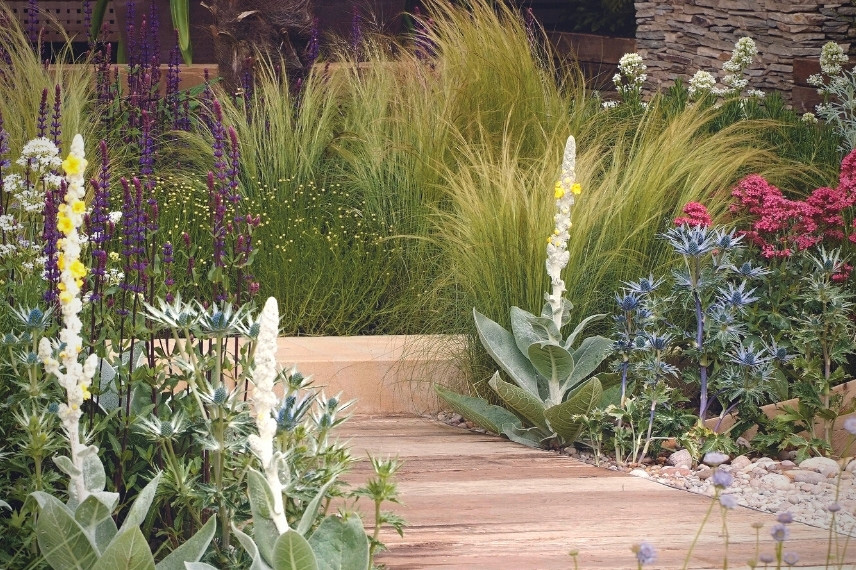
Eryngium oliverianum, Verbascum ‘Polarsommer’, Centranthus ruber, Salvia nemorosa ‘Caradonna’, and Stipa tenuifolia (photo credit: AC – Nathalie Pasquel – MAP – Landscape designer: Robert Myers)
In an alpine rockery
Some Eryngiums grow wild in the mountains, so you can take advantage of this to create a small alpine plant bed. For example, choose Eryngium alpinum, found in the Alps, Eryngium bourgatii, which grows in the Pyrenees, or Eryngium zabelii, a hybrid of the two. Create a small rockery and incorporate plants that grow spontaneously at altitude. Most of these plants are small and have a carpet or cushion habit, allowing them to better withstand strong winds, cold, and sun… like Androsace sarmentosa, Arenaria montana, Anthyllis montana, Dryas octopetala, the houseleek Sempervivum arachnoideum, or Silene acaulis. Also consider Edelweiss, Carlina acaulis, the lovely alpine lady’s mantle, or saxifrages.
For more ideas and tips, check out our advice sheet on alpine perennial plants.
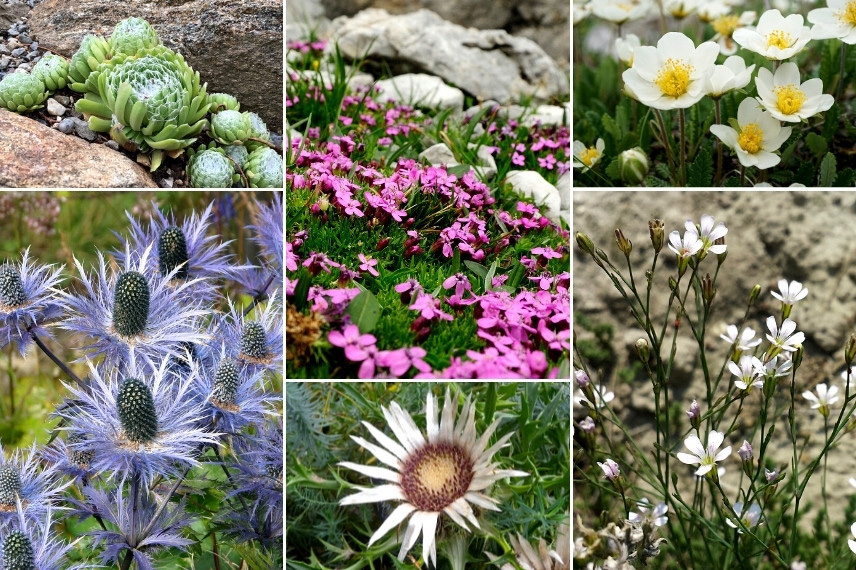
Eryngium alpinum will fit perfectly into an alpine plant rockery! Here, Sempervivum arachnoideum, Silene acaulis, Dryas octopetala, Eryngium alpinum, Carlina acaulis, and Petrorhagia saxifraga (photos: Kristine Paulus / Philipp Weigell / xulescu_g / peganum / MurielBendel / Stefan.lefnaer)
Discover other Eryngium - Eryngo
View all →Available in 1 sizes
Available in 2 sizes
Available in 1 sizes
Available in 2 sizes
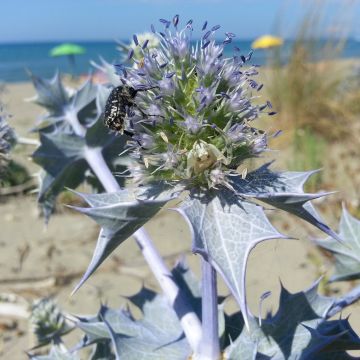
Available in 2 sizes
Available in 1 sizes
Available in 1 sizes
Available in 1 sizes
Available in 2 sizes
Available in 1 sizes
In a naturalistic garden
With its thistle-like appearance and airy, graphic look, Eryngium seems destined for naturalistic gardens! It brings a touch of structure and rigidity, pairing impeccably with the soft, airy stems of gauras, Buenos Aires verbenas, sanguisorbes, knauties, and scabious… For this type of border, we particularly recommend the classic Eryngium planum or the unique Eryngium tripartitum, whose ramified stems seem to go in all directions! Also discover the Eryngium ebracteatum var. poterioides, whose very light inflorescences resemble those of sanguisorbes. It is perfect for complementing the lightness of grasses, such as Stipa tenuifolia or Pennisetums. Feel free to plant alongside them ‘Terracotta’ yarrow, Perovskia, and ‘Mystic Spires’ sage. Create a joyful tangle where plants intertwine, a garden that resembles a wild meadow! You can particularly highlight this style of garden by defining these wild areas with clean borders or paths where the lawn is carefully mown, creating a lovely contrast in shape!
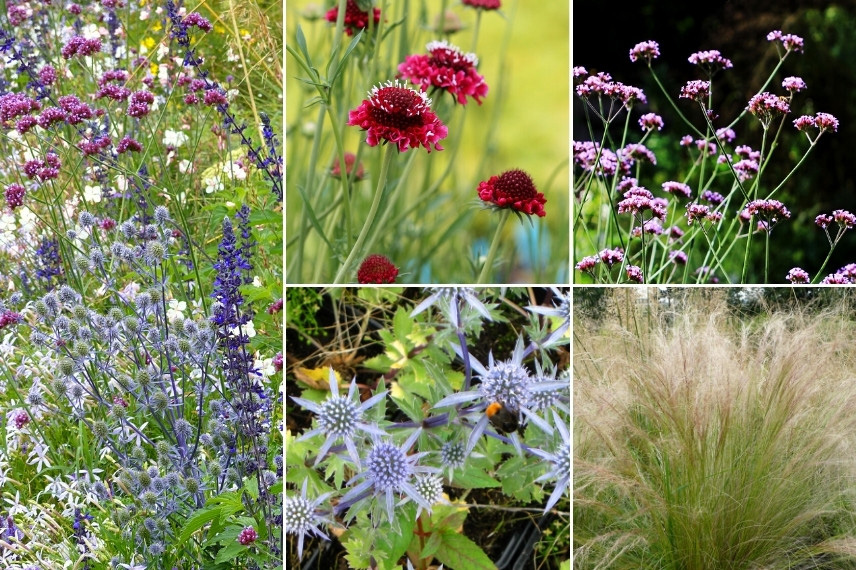
Eryngium is perfect in a naturalistic style garden! Here, a scene with Verbena bonariensis, Salvia ‘Mystic Spires’, and Eryngium planum / Scabiosa atropurpurea ‘Scarlett’ (photo: anniesannuals), Verbena bonariensis (photo Karelj), Eryngium tripartitum, and Stipa tenuifolia
Read also
Choosing an EryngiumIn a seaside garden
The Eryngium maritimum, which naturally grows along the coast in France, is particularly suited to seaside gardens. It is not afraid of sandy soils or sea spray, making it perfect to accompany Armeria maritima, agapanthus, Delosperma, and Helichrysums. Also enjoy the majestic silhouette of agaves, which will bring graphic elements and exoticism to your garden. You can also plant the lovely little grass Lagurus ovatus! Additionally, plant sea lyme grass, Ammophila arenaria, a seaside grass that helps stabilise the soil with its deep roots. Moreover, its light foliage undulates in the wind, creating a beautiful sense of movement! For shrubs, consider Pittosporum tobira, strawberry tree, Griselinia, gorse, tamarisk… They can serve as windbreaks to protect more sensitive plants.
For more tips on designing a seaside garden, discover our dedicated guide.
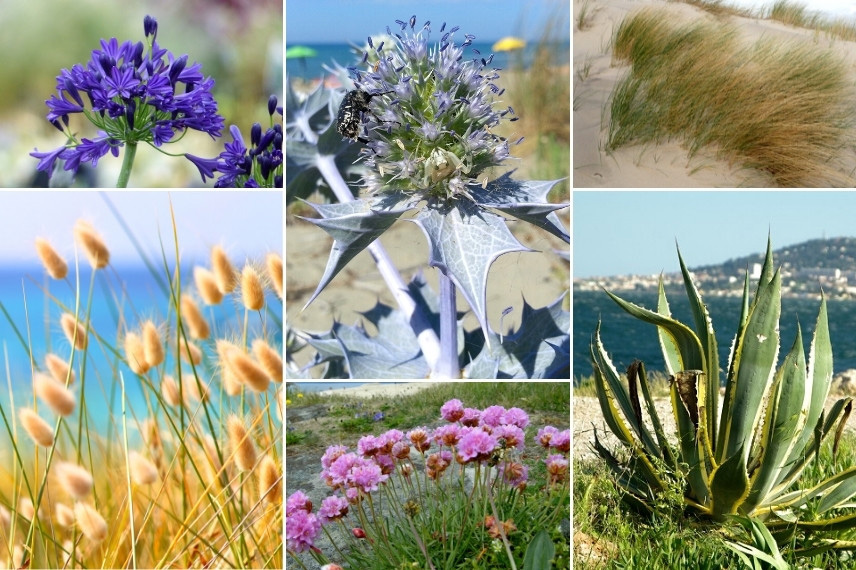
The Eryngium maritimum will naturally find its place in a seaside garden! Agapanthus ‘Royal Velvet’, Eryngium maritimum, Ammophila arenaria (photo Krzysztof Ziarnek, Kenraiz), Lagurus ovatus (photo AdobeStock), Armeria maritima (photo Arnstein Rønning), and Agave americana ‘Variegata’
In a graphic, contemporary garden
Eryngium has impeccable graphics; its silhouette and metallic blue or silver hue make it an undeniably modern plant, very much in vogue. It will easily find its place in a city garden with impeccable design. We particularly recommend the Eryngium yuccifolium, which offers a ramified flowering made up of small white spheres. Create a sleek garden, with formal, well-defined lines, straight lines and a few curves, a Japanese stepping stone path, trimmed boxwood borders, and a perfectly mown lawn… To line the paths, choose graphic plants, such as Echinops, Alliums, Agapanthus, or Veronicastrum. Play with contrasts of shape and texture to break the straight and sharp lines, using plants with free and airy forms: gauras, perovskia, Verbena bonariensis… In the same spirit, consider grasses: they will bring movement and lightness. You might choose Calamagrostis brachytricha, Stipa pennata, Pennisetum, Carex buchananii… For the flowers, favour subtle shades: white, silver, dark red, or purple, but avoid garish colours. You will undoubtedly achieve a sober and elegant garden, a space that feels timeless.
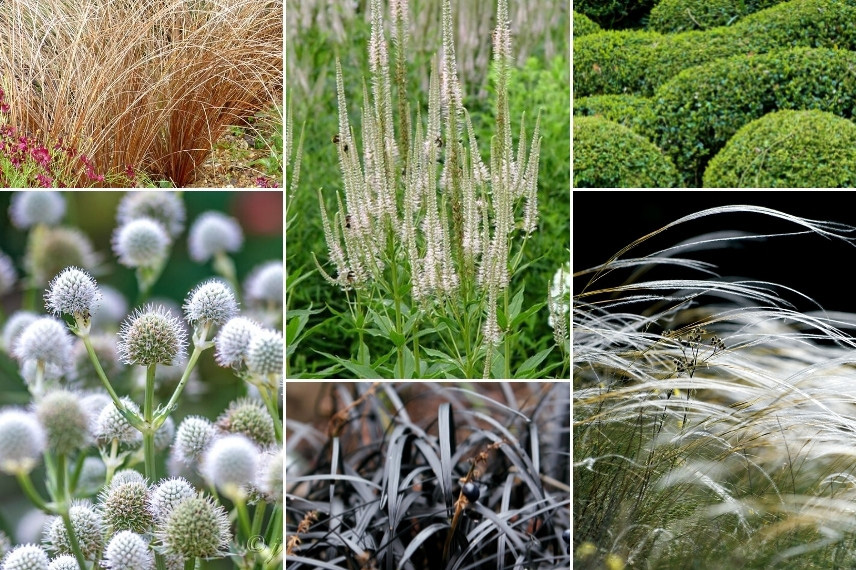
Eryngium is ideal in a graphic garden! Carex buchananii, Veronicastrum virginicum ‘Album’, Buxus microphylla ‘Faulkner’, Eryngium yuccifolium (photo J. Van Cise), Ophiopogon planiscapus ‘Nigrescens’ (photo brewbooks) and Stipa pennata (photo iStock)
In an exotic and lush garden
Some Eryngiums offer truly exotic foliage! This is the case for Eryngium agavifolium, E. pandanifolium, and E. yuccifolium. Their leaves form large, very elegant and graphic clumps. They will be perfect for enhancing the edge of a pool and creating a holiday-like atmosphere! Bring a beautiful lush setting with the generous foliage of palms, banana plants, Fatsia japonica, tetrapanax, yuccas, phormiums, and cordylines… Add colour with the vibrant flowering of kniphofias, crocosmias, and daylilies. Also enjoy the splendid Giant Himalayan Lily, Cardiocrinum giganteum. You will easily create a very exotic atmosphere!
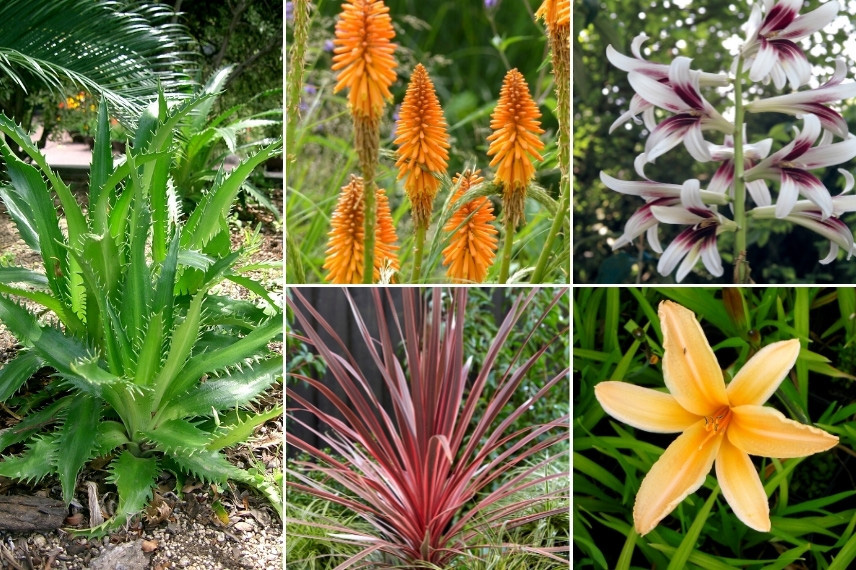
Eryngiums can also find their place in an exotic-style garden. Here, Eryngium agavifolium (photo KENPEI), Kniphofia ‘Fiery Fred’, Cardiocrinum giganteum, Cordyline ‘Charlie Boy’ (photo Plantipp), and Hémérocalle ‘George Cunningham’
- Subscribe!
- Contents
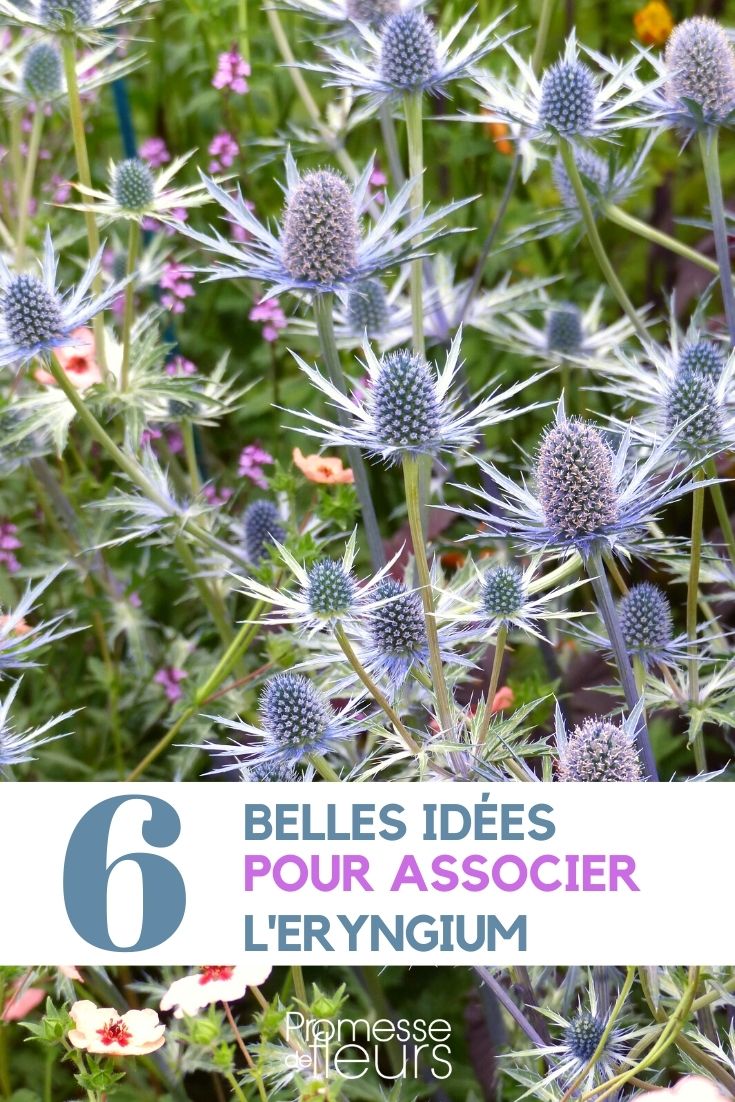































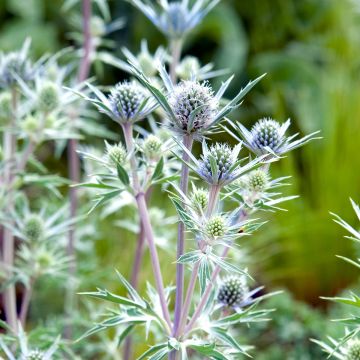
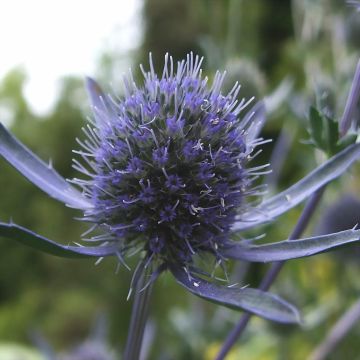
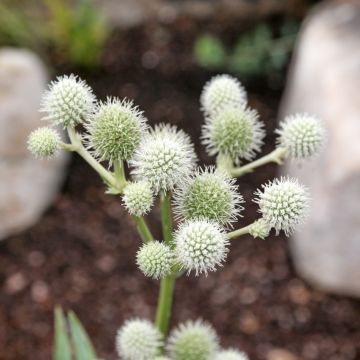
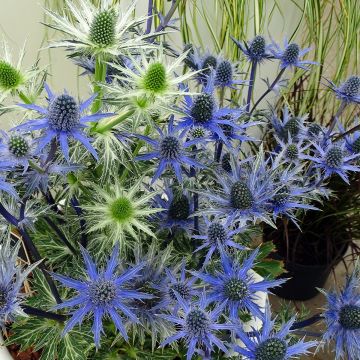
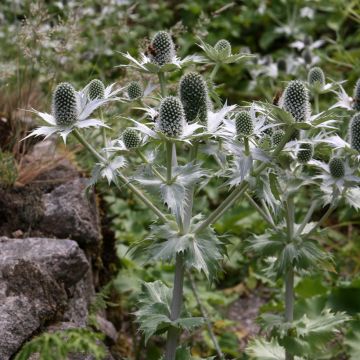
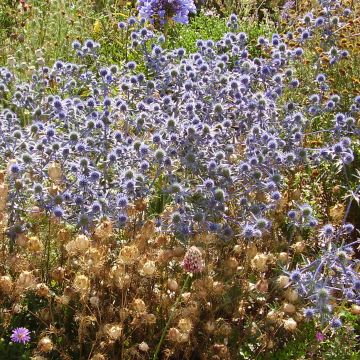
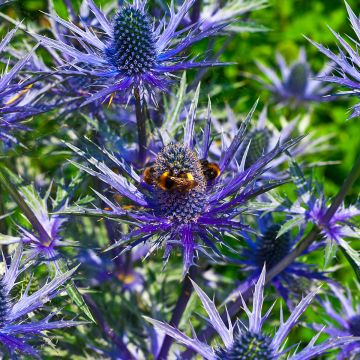
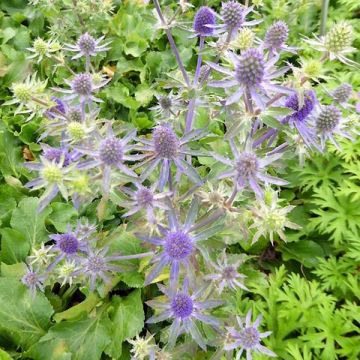
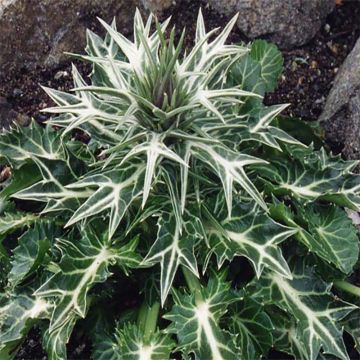
Comments